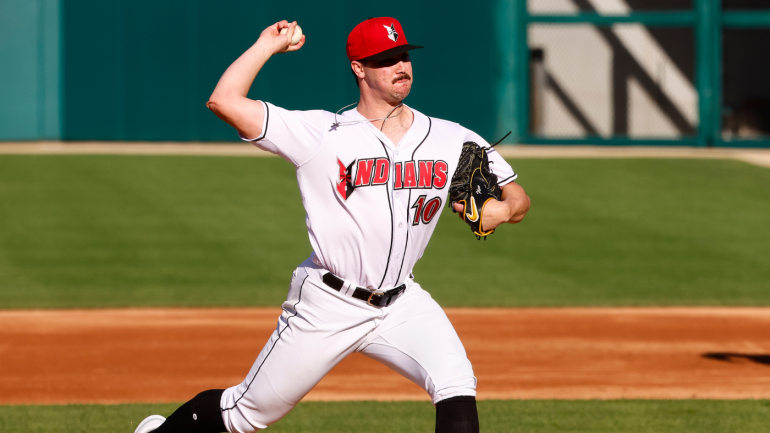
Paul Skenes, the No. 1 pick in last summer's draft by way of LSU, had become the subject of weekly check-ins over the season's first month-plus. Everyone who has seen Skenes, and who has become enamored with his extreme brand of power pitching, had the same inquiry on their mind: when, oh when, will the Pirates promote him? We got the official answer on Wednesday.
Skenes is being called up by the Pirates and will make his MLB debut on Saturday against the Cubs.
Skenes made seven starts in Triple-A this year, amassing a 0.99 ERA and a 5.63 strikeout-to-walk ratio in 27 1/3 innings. He's struck out 42.9% of the batters he's faced thus far this season, suggesting that he is more than ready for his promotion.
To honor Skenes' call-up, and to indulge in everyone's blooming fascination with him, we've answered four pertinent questions about him and his game below. Those questions include what makes him so notable, why he's remained in the majors, and when we think he'll debut. Now, let's get to it.
1. What makes Skenes so notable?
In our estimation, Skenes' mainstream appeal can be attributed to a confluence of factors. He throws extremely hard. He was the No. 1 pick in last summer's draft after playing ball for a prestigious program. He throws extremely hard. He's part of a power couple. And did we note that he throws extremely hard? Velocity sells, baby; always has, always will.
Paul Skenes 💯⛽️ pic.twitter.com/JMX5sHhzKu
— Rob Friedman (@PitchingNinja) April 30, 2024
Beyond that, Skenes was something of a polarizing prospect in last summer's draft. CBS Sports spoke to several scouts and analysts who did not consider him the best choice at the top of the draft because of reasons we outlined at the time:
Skenes is an imposing figure with upper-90s velocity and a strikeout rate near 48% against SEC hitters. About 15 years ago, that would've been enough to land him higher on this list (and the belief is he might go as early as No. 2 overall, with several sources identifying him as the Nationals' kind of pitcher). Those within the industry are convinced that ball-tracking data has improved their ability to evaluate pitches. Those advancements have made Skenes a divisive figure, with scouts and analysts who spoke to CBS Sports expressing reservations about his fastball shape. The short version is that his four-seamer features minimal separation between its induced vertical break and its horizontal break, putting it in the "dead zone." The fear is Skenes' four-seamer will play down as a result, causing him to underperform draft night expectations. Consider Nathan Eovaldi, another big-armed righty with minimal separation; prior to this year, opponents had hit .300 or better against his fastball in three consecutive seasons. Skenes' velocity may mitigate some of the effect, and it's possible his employer will help him find a better shape, or will have him shift to his sinker (his current one features more run than Dustin May's). Factor in the probabilistic analysis argument that arises whenever a pitcher is part of a class loaded with good hitters, and that's why he's lower than you might have expected, even if he still goes No. 2.
The Pirates took Skenes at No. 1 anyway, suggesting they weren't too concerned about his perceived flaws. Fair enough. We bring it up only because it's an undeniable part of contemporary human life that friction, if only the possibility of it, attracts attention. We think Skenes would've captured the Collective Imagination regardless -- have you heard he throws extremely hard? -- but consider this extra fuel on the flame.
2. Anything else to know about Skenes' arsenal?
First, let's lay out Skenes' arsenal. So far this season, he's thrown what amounts to five pitches: a four-seam fastball, a sinker, and a slider form the backbone of his repertoire. He's also sprinkled in some changeups and curveballs, but even combined they represent less than 10% of his usage so we're going to ignore them in this section.
Skenes' four-seamer averages 100 mph, which would make it the hottest in the majors among starters. The only pitcher to throw 50 or more four-seamers this season and top Skenes' average velocity is Oakland Athletics closer Mason Miller (100.8 mph). That Skenes is able to maintain such heat is a testament to how special he is physically.
We mentioned above that Skenes' fastball shape has raised some eyebrows. Past research has found that fastballs that have similar vertical and horizontal break are easier for hitters to track, causing them to play less effectively than expected. Skenes' fastball has averaged 13.4 inches of induced vertical break and 14.3 inches of horizontal break, providing little separation between the two planes.
(Stats from Skenes' first six MiLB starts this year)
| Pitch | Usage% | Velocity | Average EV | Whiff% |
|---|---|---|---|---|
Four-seamer | 46.9% | 100 mph | 85.4 mph | 34% |
Slider | 25.3% | 86.5 mph | 82.9 mph | 44.2% |
Sinker | 18% | 94.8 mph | 81.0 mph | 38.2% |
Will that matter? There's a school of thought that says no, because of Skenes' elite velocity and above-average control. There's also a school of thought that says it might -- just look at Hunter Greene and Nathan Eovaldi, two power righties who have had solid careers, albeit, perhaps, while underperforming compared to the gaudy velocity they generate on their fastballs. That first school of thought has been correct so far. We can only wait and see if it proves to be the case at the big-league level.
Skenes' most-used secondary pitch is an 86.5 mph slider that served as his outpitch at LSU. He generates close to seven inches of glove-side break and around seven inches of induced vertical break. If you're looking for a MLB comparison, those numbers are similar to what Tampa Bay Rays right-hander Ryan Pepiot generates on his own slider.
Then there's the sinker, a new addition to his arsenal that has inspired comparisons to Minnesota Twins' closer Jhoan Duran's splinker -- that is a splitter-sinker hybrid. Some pitch classification models are calling it a splitter; Skenes told our Matt Snyder that it's just a sinker in his mind.
Paul Skenes, 7Ks in 4.1 innings.
— Rob Friedman (@PitchingNinja) April 24, 2024
[12 whiffs. 21 pitches at 99mph or higher. Lots of Splinkers today.] pic.twitter.com/8CujQ03fG6
Whatever you call it, the pitch generates 15 inches of arm-side break and 0.6 inches of induced vertical break. There are exactly three pitchers who throw sinkers that have at least 14 inches of arm-side break and two inches or fewer of induced vertical break: Yannier Cano, Tanner Houck, and Logan Webb. That's pretty good company to keep.
To state the obvious, having three quality pitches is better than having two quality pitches. We think it's fair to assume that Skenes' sinker changes the dynamic of his arsenal in a way that should help mitigate whatever (if any) ill effects his four-seamer's shape has on its effectiveness. He now has three legitimate weapons to use, each having shown a capacity for missing bats and evading barrels. There aren't many pitchers, in the majors or anywhere else, with that kind of power arsenal.
3. How good could Skenes be?
In the magical world of baseball scouting parlance, you have what evaluators refer to as dudes and and you have what they refer to as Dudes. A dude is just a guy; a Dude is The Man. Got it? Good, because Skenes certainly has the look of a Dude. In layman's terms, he could well become a No. 1 or 2 starter. (And before anyone yells at us for daring to suggest he won't be a No. 1, mind you that that designation is reserved for fewer than a dozen pitchers; there's no shame in being the 13th or 14th or 17th best starting pitcher in all of MLB.)
Now, no one can guarantee that Skenes is going to become the new Gerrit Cole. Baseball just doesn't work like that. Sometimes players fail to meet expectations; other times it takes them longer than expected to live up to their promise. Heck, Cole himself is a good example of that: he was the No. 1 pick in the 2011 draft, yet he didn't make an All-Star Game or receive a Cy Young Award vote until his third season, when he was 24. He then didn't accomplish either of those feats again until his age-27 campaign.
Paul Skenes, 8Ks in 3.1 innings. pic.twitter.com/U3P5RSfBGo
— Rob Friedman (@PitchingNinja) April 18, 2024
For another example of how Skenes' career could play out, consider Stephen Strasburg. Everyone undoubtedly remembers how he came into the majors with as much hype as any pitcher in recent memory; how he got hurt; how he then inspired nonstop discourse when the Washington Nationals shut him down early in 2012; and so on. Anyway, Strasburg made his first All-Star Game at 23, and received his first Cy Young Award consideration at age 25. He didn't repeat either feat until his age-27 season.
The Pirates can only hope that Skenes can achieve the heights that Cole and Strasburg have without enduring either years of underperformance or injury. Do you hear that? It sounds like a convenient segue opportunity.
4. Why wasn't Skenes already in the majors?
To put it in a sentence: the Pirates have taken a very conservative approach to Skenes' workload. He didn't pitch into the fifth inning as a professional until three starts ago.
Skenes was used aggressively last year at LSU, throwing 122 innings and clearing the 100-pitch mark more than 40% of the time. That percentage, by the way, was well beyond those of his peers. The Pirates have veered in the other direction. Hence Skenes tallying all of 29 innings across his first 11 professional starts.
You might question the wisdom of Pittsburgh's approach, or the potential effectiveness of it -- you'll never go broke betting on any and every individual pitcher getting hurt at some point. Still, it's hard to blame the Pirates for trying to keep their talented young pitcher healthy at a time when the league is dealing with an arm-injury epidemic.






















